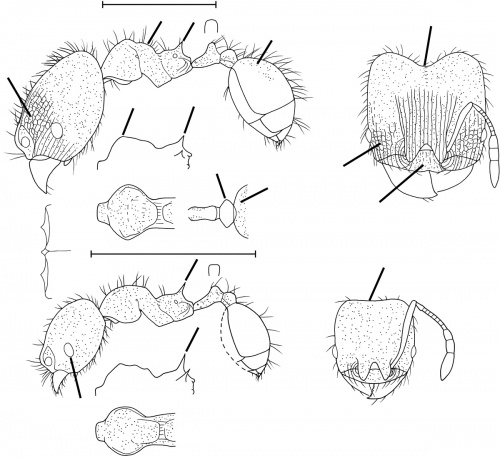Pheidole oaxacana
| Pheidole oaxacana | |
|---|---|
| Scientific classification | |
| Kingdom: | Animalia |
| Phylum: | Arthropoda |
| Class: | Insecta |
| Order: | Hymenoptera |
| Family: | Formicidae |
| Subfamily: | Myrmicinae |
| Tribe: | Attini |
| Genus: | Pheidole |
| Species: | P. oaxacana |
| Binomial name | |
| Pheidole oaxacana Wilson, 2003 | |
This species is only known from type specimens. Nothing is known about its biology.
Identification
See the description in the nomenclature section.
Keys including this Species
Distribution
Only known from the type locality.
Latitudinal Distribution Pattern
Latitudinal Range: 19.5116667° to 16.097°.
| North Temperate |
North Subtropical |
Tropical | South Subtropical |
South Temperate |
- Source: AntMaps
Distribution based on Regional Taxon Lists
Neotropical Region: Guatemala, Mexico (type locality).
Distribution based on AntMaps
Distribution based on AntWeb specimens
Check data from AntWeb
Countries Occupied
| Number of countries occupied by this species based on AntWiki Regional Taxon Lists. In general, fewer countries occupied indicates a narrower range, while more countries indicates a more widespread species. |

|
Estimated Abundance
| Relative abundance based on number of AntMaps records per species (this species within the purple bar). Fewer records (to the left) indicates a less abundant/encountered species while more records (to the right) indicates more abundant/encountered species. |

|
Biology
Castes
Nomenclature
The following information is derived from Barry Bolton's Online Catalogue of the Ants of the World.
- oaxacana. Pheidole oaxacana Wilson, 2003: 476, figs. (s.w.) MEXICO.
Unless otherwise noted the text for the remainder of this section is reported from the publication that includes the original description.
Description
DIAGNOSIS Similar in different traits to Pheidole mixteca, Pheidole scabriventris and Pheidole tragica, also from Mexico, differing as follows.
Major: a broad rugoreticulum occurs between eye, antennal fossa, and frontal carina on each side of the head; midclypeus partially carinulate, and carinulae travel from the frontal lobes across the vertex but fall short of the occiput; all of head and mesosoma foveolate and opaque; anterior half of central strip of first gastral tergite shagreened; occipital cleft broad and deep; propodeal spines robust and backward-directed; postpetiole from above diamond-shaped.
Minor: eye set well forward on head; propodeal spines half as long as the propodeal basal face and backward-directed; pilosity sparse; occiput broad, its margin concave, and lacking nuchal collar. All of head and mesosoma foveolate and opaque.
MEASUREMENTS (mm) Holotype major: HW 0.92, HL 1.00, SL 0.50, EL 0.14, PW 0.46. Paratype minor: HW 0.50, HL 0.52, SL 0.42, EL 0.06, PW 0.32.
COLOR Major: body and mandibles medium reddish brown, other appendages dark yellow.
Minor: concolorous light reddish yellow.
Figure. Upper: holotype, major. Lower: paratype, minor. Scale bars = 1 mm.
Type Material
MEXICO: 10 km south of Valle Nacional, Oaxaca, 610 m, col. S. Peck. Museum of Comparative Zoology
Etymology
Named after the state of origin of the type colony.
References
- Wilson, E. O. 2003. Pheidole in the New World: A dominant, hyperdiverse ant genus. Harvard University Press, Cambridge, MA. (page 476, fig. major, minor described)
References based on Global Ant Biodiversity Informatics
- Dattilo W. et al. 2019. MEXICO ANTS: incidence and abundance along the Nearctic-Neotropical interface. Ecology https://doi.org/10.1002/ecy.2944
- Vásquez-Bolaños M. 2011. Lista de especies de hormigas (Hymenoptera: Formicidae) para México. Dugesiana 18: 95-133
- Wilson, E.O. 2003. Pheidole in the New World: A Dominant, Hyperdiverse Genus. Harvard University Press
